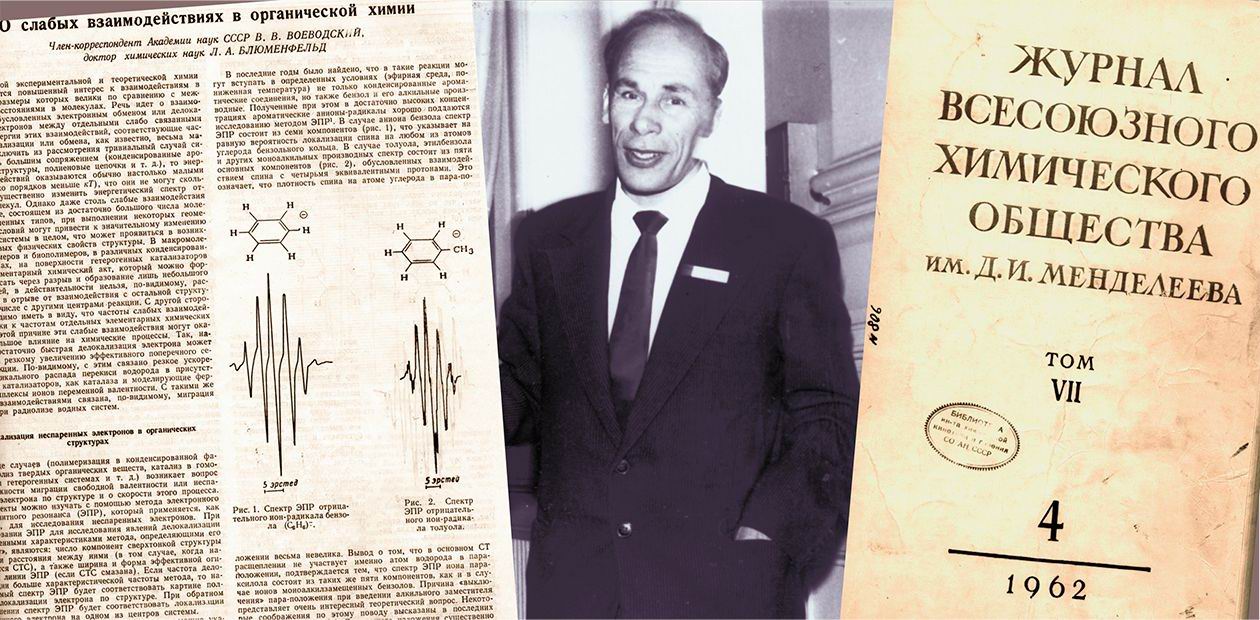The Strength of Weak Interactions
Well-known works on the elaboration and application of physical methods in chemistry are connected with the name of Academician V. V. Voevodsky. Voevodsky was one of the first scientists in the USSR to realize the importance of applying radiospectroscopy methods, especially, electron paramagnetic resonance, to chemical research. He can be rightfully named among the fathers of the new scientific field, chemical magnetic radiospectroscopy. However, the elaboration of new methods had never been an end in itself for Voevodsky: he aimed at proposing general chemical ideas covering the interfaces of different sciences. The idea about the role of weak interactions in chemistry appeared to be one of the brightest. Due to his surprising intuition, Voevodsky foresaw the emergence of a new scientific direction, known today as supramolecular chemistry.
“Voevodsky pioneered in apprehending the amazing adequacy of magnetic radiospectroscopy methods to chemical problems; the adequacy is eventually determined by the fact that the frequency range used in these methods is close to the inverse times of elementary chemical events. He was convinced that the behavior of a chemical process was determined not only by the strong interactions connected with large changes in the energies of reacting particles, but also by weak interactions, controlling the process and determining its likelihood yet leaving the energy spectrum virtually intact” (International Collection of articles in Memory of V. V. Voevodsky, 1972).
These comments appeared after an untimely decease of the scientist. The followers of Voevodsky actively joined in the elaboration and development of the direct physical methods for studying weak intermolecular and intramolecular interactions, as well as the search for chemical processes where such interactions could play a decisive role.
1962. The conceptual paper entitled “On Weak Interactions in Organic Chemistry” appeared, and spin chemistry is a brilliant example of the development of the ideas formulated in this article
Voevodsky’s labs in Novosibirsk and Moscow conducted a comprehensive series of studies into the delocalization of the unpaired electron in complex compounds and stable free radicals. Later, the research commenced in Voevodsky’s labs focused on the processes of spin transfer (spin exchange) in solutions, where, as it was demonstrated, the weak interactions determined by the spin density delocalization, were of great importance. The monograph consolidating the results of this research (Spin Exchange, 1980) is still widely cited and remains the theoretical foundation for the chemical and molecular biological studies using spin probes.
The late 1960s — early 1970s brought the discoveries of new phenomena that could be regarded as a brilliant illustration of the role of weak interactions in chemical reactions. These are the so-called magnetic spin phenomena, comprising the chemical polarization of nuclei and electrons as well as the effects of constant and alternating magnetic fields and the fields of magnetic nuclei on the reactions of free radicals. In these reactions, it is the weak magnetic interactions that “control” the orientation of electron spins and, consequently, the progress of an elementary chemical act in solutions. This research direction was comprehensively developed later and became known as spin chemistry.
Academician V. V. Voevodsky:
“The modern experimental and theoretical chemistry displays an increased interest in the interactions in structures whose sizes are large compared with the interatomic distances in molecules. These are the interactions determined by the electron exchange or delocalization of electrons between separate but weakly bound centers. As is known, the energies of these interactions, which correspond to the delocalization or exchange frequencies, are very small. Excluding from consideration the trivial case of systems with very strong coupling (condensed aromatic structures, polyene chains, etc.), we get interaction energies so small (by several orders of magnitude smaller than kT) that they are unable to alter the energy spectrum of individual molecules. However, even such weak interactions in a “team” comprising a sufficiently large number of molecules of particular types and provided that certain geometric conditions are met can lead to a considerable change in the energy of the entire system, possibly producing new physical properties of the structure. In the macromolecules of polymers and biopolymers, in various condensed systems, and on the surface of heterogeneous catalysts, the elementary chemical event, which can be formally describabed via the break and formation of a small number of bonds, cannot actually be considered ignoring the rest of the structure, in particular, other reaction centers. On the other hand, it is necessary to keep in mind that the frequencies of weak interactions are close to the frequencies of individual elementary chemical events. That is why these weak interactions can essentially influence the chemical processes. For example, a sufficiently rapid delocalization of an electron can increase drastically the cross-section of a reaction”*.
* Zhurnal Vsesouznogo khimicheskogo obshchestva im. Mendeleeva (Journal of the Mendeleev All-Union Chemical Society), 1962, vol. VII, no. 4.
Voevodsky’s scientific schools of contributed greatly to the establishment and advancement of this new direction in chemical physics and were awarded the Lenin Prize in 1986 for a series of works on magnetic spin effects in chemical reactions.
The modern research in the field of spin chemistry is conducted both abroad and in this country, including the Siberian Branch of the Russian Academy of Sciences — the Institute of Chemical Kinetics and Combustion and the International Tomography Center. All work is coordinated by the International Committee on Spin Chemistry, where two Novosibirsk scientists represent Russia. On a biennial basis, this Committee organizes international conferences in various countries; there, the delegations of the Siberian Branch are usually the most widely represented and the youngest.
Academician Voevodsky deceased when he was still under 50 years old. The State Prize for the series of works “Physics and Chemistry of Elementary Chemical Processes” was awarded to him posthumously. Every five years, conferences in memory of Voevodsky are organized alternately in Moscow and Novosibirsk. A street in Akademgorodok, an international scientific prize, a prize for young scientists of the Siberian Branch of the Russian Academy of Sciences, and a scholarship for Novosibirsk State University students are named after him. The memory of Academician Voevodsky is perpetuated by a memorial plaque on the Institute building and, what is most important, his thoughts and ideas that continue their existence in the work of his followers.






